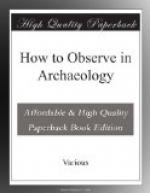For (1) there is no need to get an impression of the hollows to the bottom, and the face of the paper should be smooth. A soft paper, with little or no size, and a soft clothes-brush will do well for this. The sheet should cover the whole inscription, or have as few joints as may be. The stone should be dabbed with a wet brush so as to saturate the face, the sheet of paper well soaked in water laid upon it, taking care not to leave bubbles, and then dabbing firmly with the brush will drive the paper into the hollows. If the stone is polished or very smooth, it is needful to peel off the paper while wet by holding two corners, and lay it reversed on a flat surface to dry; if left on the stone the contraction will destroy the impress. Out of doors the paper can be held down by pebbles around it, or by sand on the edges, to prevent the wind catching it.
(2) The stronger squeeze should be of a tough paper with moderate sizing. Cut the paper to the form of the stone. Thrust it into a pail of water, knead it about vigorously, roll it into a ball and pummel it, so as to break the grain and let the water well into it. Then wet the stone, shake out the paper like a wet handkerchief, full of creases, lay it on the stone and begin to beat it in with a hard, long spoke-brush. A few strokes round the edge will catch it down so that the wind does not disturb it. Then begin to beat it heavily along the top edge; beat it to a pulp, and patch with strips left soaking in the water wherever breaks occur. If the stone is porous the paper may part from it, especially if expanded by beating; the only course then is to slush more water on the face so that it will go through the breaks and hold the paper down again. It may be needful to slit the paper to let the water go below it. Beat down again, enough to fix it.
(3) For casting purposes a final backing sheet, moderately beaten on, is needed to hold the squeeze together and stiffen it. Either (2) or (3) can be left on the face of the stone till quite dry, and then carefully detached by lifting up from one corner, and slipping a dinner-knife or a slip of wood under the paper to lift any part that sticks.
Stiff squeezes as (3) must be packed flat; thin, as (1) and sometimes (2), may be rolled in a large curve, but this always deteriorates a squeeze.
For plaster casting, a squeeze should be heated on a stove and brushed over with melted paraffin, or better wax, sufficient to cover the face without choking the finer detail. Before each cast the face should be lightly oiled with a tuft of wool.
Small objects. These can be copied by a thin paper squeeze, and the squeeze may be mounted by pasting a card and lightly pressing the squeeze back down on it. This will take out all cockling and make it lie flat for photographing.
Tin-foil is very handy for squeezes, and may be saved from chocolate for this. Press it firmly on a coin or seal with a tuft of wool, or beat it with a soft tooth-brush, being careful to avoid creases. The foil should then be floated on water, hollow back up, and blazing sealing-wax dropped into it to back it. The resulting positive can be then stuck on card.




